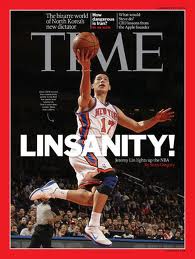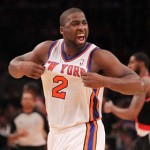 At this point, chances are that you’re well aware of the Jeremy Lin story if you’re reading this article. If not, welcome back from Pluto.
At this point, chances are that you’re well aware of the Jeremy Lin story if you’re reading this article. If not, welcome back from Pluto.
Lin captivated the sporting world with his spirited play for the Knicks last season, and now starts for the Rockets after signing a $25 million offer sheet last summer. This week I will examine Lin’s impact on both New York and Houston a year after the “Linsanity” phenomenon.
Anyone’s year-to-year stats can’t be compared in a vacuum, and there are numerous factors to consider when observing Lin’s time with the Knicks and Rockets. Carmelo Anthony’s seven-game absence in February of 2012 helped Lin become a focal point of the New York offense, while Houston’s acquisition of James Harden means that Lin plays more of a supporting role in Houston’s fast-paced, high octane offense.
| The Basics | Games | Min/Game | PPG | APG | RBG | FG% | 3FG% | Usage |
| 2011-2012 | 35 | 26.9 | 14.6 | 6.2 | 3.1 | 0.446 | 0.32 | 28.1 |
| 2012-2013 | 61 | 32.5 | 12.8 | 6.2 | 3.3 | 0.436 | 0.324 | 20.1 |
Those factors play out in the statistics. Lin’s role has been more defined this season, which explains his uptick in minutes per game on the Rockets along with the lower usage rate (a percentage of a team’s plays used by a player while he’s in the game) since Harden has the 8th highest usage rate in the league (Anthony has the highest usage rate in the league this season).
So the scoring average is down, but not very much considering his usage rate decrease, but most of his numbers are pretty much per game. Lin has also proven to be valuable in creating turnovers, with the fourth most steals in the league.
However, it evens out considering he’s also committed 176 turnovers, which is the 8th most in the league (Harden and Kobe Bryant have committed the most turnovers this season). Those turnovers have an impact on his efficiency ratings:
| Lin Efficiency | PER | O Rtg | D Rtg | WS/48 |
| 2011-2012 | 19.9 | 104 | 101 | 0.140 |
| 2012-2013 | 14.9 | 105 | 107 | 0.092 |
It seems like Lin’s increased minutes has harmed his Player Efficiency Rating and his Win Shares per 48 minutes (which is explained here), but his offensive impact is about the same and his defensive rating could be chalked up to the fact that Houston has one of the worst defenses in the league as a team (which you’ll see later on in this piece). Offensive and defensive ratings quantify points scored or produced per 100 possessions.

Going back to last summer when Lin signed the offer sheet with Houston as a restricted free agent, the Knicks decided to use its salary space on Raymond Felton and Jason Kidd (among others) instead of matching the Rockets’ “poison pill” three-year deal, which guaranteed an eight-figure salary cap number in the final year of the deal.
So New York swung a deal with Portland to trade for Felton, who had done a nice job on the Knicks until he was part of the package sent to Denver in the Anthony trade. So in comparing Lin with his main replacement for New York, we see that there isn’t a huge difference between the two.
| PG Comparison | Games | Min/Game | PPG | APG | RBG | FG% | 3FG% | Usage | WS/48 | PER |
| Lin | 61 | 32.5 | 12.8 | 6.2 | 3.3 | 44 | 32 | 20.1 | 0.092 | 14.9 |
| Felton | 44 | 34 | 14.7 | 5.9 | 2.9 | 40.4 | 34.5 | 24.1 | 0.065 | 14.8 |
Surprisingly, Felton is a pretty large focal point of the Knick offense, with a large hand in nearly a quarter of the team’s possessions while he’s on the floor. Felton scores roughly two more points per game than Lin, but the shooting percentages, points, rebounds, assists and PER are basically a wash. Lin’s ability to create turnovers pushes him over the edge in terms of per game win shares, but New York and Houston have very similarly valued point guards right now.
The whole point of signing a player like Lin to a lucrative contract is to have your team improve with him in the lineup, while the Knicks wanted to at least be just as good offensively at a lower cap number than Lin would have brought. How did Houston fare?
| HOU (League Rank) | Offense | Defense | FG% | 3FG % |
| 2011-2012 | 98.1 (9) | 97.9 (19) | 44.9 (14) | 35.9 (9) |
| 2012-2013 | 107 (1) | 103.7 (29) | 46.6 (6) | 37 (7) |
Houston signed Lin and Omer Asik and really decided to speed up the team’s style of play with the acquisition of Harden. The results have clearly been positive for the Rockets, who now boast the top scoring offense in the NBA with improved field goal percentages overall and from three. Lin certainly plays a part in that improvement, but it would be foolish to say he’s the primary reason for putting Houston in a good position to make the playoffs.


Good analysis. But it doesn’t take into account that Lin is young and improving, while Felton is an older vet who has already peaked and may actually regress some since Felton doesn’t seem to take care of his body that much.
This can be seen in Lin’s numbers getting better mo th to month, while Felton’s have decreased month to month.